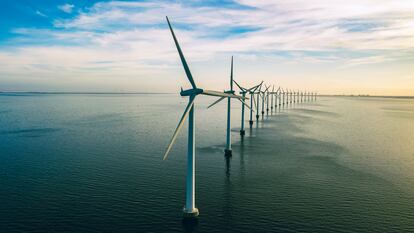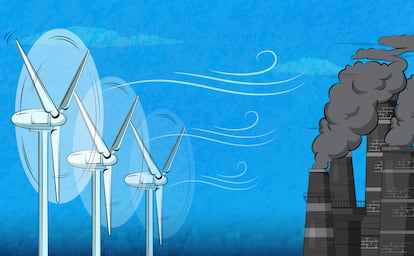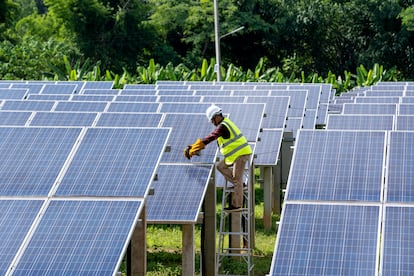Harnessing the power of wind to decarbonize the electricity grid
Accelerating permits for capacity expansion and extending transmission networks will fuel the growth of wind energy development
For centuries, the wind has been humanity’s steadfast companion. It carried the Egyptians on their sailing voyages along the Nile 5,500 years ago. Centuries later, the Persians harnessed wind to power mills and grind grains efficiently. And in the mid-15th century, multi-masted sailing ships united the far-flung corners of the Earth. In the 21st century, this weather phenomenon remains vital for society. While the implementation of this energy source in the U.S. is well underway, the industry is facing challenges.
Wind is an incredibly efficient source of renewable energy, playing a crucial role in meeting the growing electricity needs of our society and combating climate change caused by fossil fuel emissions.
Global clean energy leader Iberdrola has been driving the renewable energy revolution for more than two decades. Their current renewables portfolio totals 90 GW across the globe, including 1.6 GW of installed offshore wind capacity. In the United States, its subsidiary Avangrid is pioneering the offshore wind industry with its Vineyard Wind 1 project, which is set to become the first large-scale offshore wind farm in the country. With 62 wind turbines, it will generate 806 MW of clean energy. The wind farm will deliver the first power to Massachusetts this year.

“Vineyard Wind 1 is a landmark project; it is the only real big project that is being built right now in the United States and it will be a massive achievement that is going to strengthen the country’s offshore wind industry,” said Pedro Azagra, Avangrid CEO.

“Once this project of more than 800 megawatts is completed, just to give a reference, it will be perfectly enough to allow more than 400,000 Massachusetts homes and businesses to have energy and therefore, to reduce their carbon emissions by more or less 1.6 million tons per year. These are huge numbers.”
Pedro Azagra
Azagra says that he is very proud of the work men and women have done in this offshore project. “Being the first in the nation project I’m also happy that we have overcome many challenges,” he admits. “We have been learning from the experience that we have across the Iberdrola Group in Germany, in the U.K., or in France. And I think those lessons are the reason why this is going well,” Azagra says. Lessons that will be invaluable as Avangrid continue developing offshore wind projects in the U.S.
Offshore wind: a crucial part of a sustainable energy future and a lynchpin of the clean energy transition
“We need to do two big things over the next ten to thirty years,” said Ken Kimmell, Avangrid Renewables’ Chief Development Officer. “First, we must swiftly decarbonize the electricity generation system by eliminating almost all fossil fuel emissions. Second, we must expand the grid to allow other end users of energy to wean themselves off of fossil fuels with technologies such as electric cars and heat pumps.” Kimmell believes that onshore and offshore wind energy “is our best tool for facing this double challenge,” because of the large capacity of these facilities, particularly ocean-based projects that can achieve peak production capacity 50% of the time and are located near the densely populated east and west coasts.
Kimmell, a former president of the Union of Concerned Scientists, says offshore wind farms offer several advantages. They don’t have to contend for space in densely populated areas and they benefit from stronger, unobstructed winds. Taller, more efficient turbines can be built in the ocean, aligning energy demand with wind supply.

Successful implementations in several countries have demonstrated that the reliability of this energy source can be enhanced by the combination of renewable diversification, an intelligent transmission network (also known as a smart grid), and expanded storage capacity.
In October 2023, renewable energy made up 50.7% of Spain’s production, primarily driven by wind power. Germany is projected to generate over 50% of its energy from renewable sources this year. During the first half of the year, Denmark relied on wind turbines and solar panels for 67% of its electricity consumption.
In the U.S., renewable energies (primarily wind and solar) accounted for 21% of electricity production in 2022, surpassing individual generation from coal and nuclear energy, according to the Energy Information Administration (EIA). And there is plenty of room for the type of growth envisioned by the government in the Inflation Reduction Act passed in 2022. Similar to legislation in other countries, this act provides assistance to expand energy capacity and reach.
Besides its reliability, wind power offers a significant opportunity to mitigate energy and security crises like the one caused by the Russian invasion of Ukraine and the subsequent sanctions on its fossil fuel exports. More wind power facilities will enable energy independence by utilizing local resources. In a recent statement on energy security, NATO said: “Russia has intentionally exacerbated the energy crisis and its war of aggression against Ukraine impacts the global energy landscape.”
A report by the International Renewable Energy Agency (IRENA) showed that approximately 80% of the global population resides in countries that import fossil fuels, leaving much of the world at the mercy of oil and gas producers, while renewable resources are available wherever the sun shines or the wind blows.

Francesco La Camera, Director-General of IRENA, has repeatedly stressed the need for significant investment in renewable energy because “it’s not only the most cost-effective way to produce electricity, it’s also the best way to ensure energy resilience and security.”
To counter critics of wind power who dislike its variability, IRENA says the answer is having a diverse generation portfolio. By efficiently organizing the electrical system and improving interconnection, the challenges of variable production by any one energy source can be overcome.
In this regard, a lot of work needs to be done in the U.S. to remove obstacles for renewable energy development. Among other things, Kimmell points out that the U.S. electric grid is not sufficiently interconnected to share generation resources. “If a lot of wind power offshore in New England or onshore in the great plains states are producing surplus energy, we need to be able to send that power to other areas where it is needed.”
Fragmented networks and politically divided decision-making for locating major transmission lines, along with the time-consuming permitting processes, present a major challenge. Kimmell says obtaining permits for an interstate transmission line that can deliver energy to multiple states can take up to 10 years, and some projects die before getting that far.
America Clean Power (ACP), an association of companies from across the clean power sector, believes that up to 100GW of energy development projects could be lost if the permitting process is not reformed. This translates to “over $100 billion in lost investments, 150,000 jobs not created, and 55 million metric tons of emissions in one decade (equivalent to the annual emissions of 120 million cars).” For context, the ACP says two Hoover Dams or two and half Golden Gate Bridges could have been built in the decade it takes to obtain a permit.
Connecting renewable energy sources to the grid requires longer transmission lines because electricity is often generated in remote locations. Interconnection also requires flexibility in incorporating additional electricity generators and storage.
Kimmell wants to see changes in the United States that have already happened in Europe, like reducing the number of permits and streamlining the process through greater centralization. “I visited an Iberdrola project in the Baltic Sea, and I asked them, how many permits did they need to build it? Just one! But for this Vineyard Wind 1 project we’re building in the United States, we needed about 100 permits.”
Something else that caught his attention in Germany is the segregation of duties. The companies that build the offshore wind farms (turbines, blades and substations) do not handle connection to the grid for transmission, which is the responsibility of the electric utilities. This simplifies the process, reduces risk and expedites project completion.
Kimmell takes pride in Avangrid and Iberdrola’s commitment to tackling these complex challenges. “While we do need policy and permitting reform, we will always need companies like Avangrid and Iberdrola that have the capital, the know-how, and the entrepreneurial spirit to get these projects built. That is why I came to Avangrid in the first place — the time for talking about addressing climate is over — we need to build, and build now.”
Generating power and creating jobs
Decarbonizing the grid also brings economic revitalization to many areas because infrastructure development creates jobs and wealth. Based on the latest ACP data, over $270 billion has been invested in this infrastructure during the past 12 months, surpassing the total investment from 2015 to 2022. In the process, approximately 30,000 jobs were created. ACP estimates that the clean energy sector could create a million jobs by 2030 if permits could be expedited. Renewables jobs soared to 13.7 million worldwide in 2022, reports the International Labor Organization.
These jobs are experiencing rapid growth, offer competitive salaries and don’t necessarily require a college degree, although certifications and training are still necessary. “In our offshore project in the city of New Bedford (Massachusetts), I meet people who have lived there all their lives and say they’ve never seen it as bustling with activity as it is now,” notes Kimmell. Vineyard Wind 1 alone is creating 3,600 jobs in Massachusetts.
Wind projects also pay fees to the owners of the land where the facilities are located. According to the American Wind Energy Association (AWEA), wind projects contribute more than $1.6 billion in local and state taxes, as well as land rental payments to farmers and ranchers that help stabilize their businesses and stimulate local economies.

These income sources help communities, many of them in rural areas, expand their budgets and invest in education and social services. Additionally, they create local jobs and help revitalize depressed areas, keeping young families from seeking opportunities elsewhere.
Looking to the future, Kimmell predicts that by 2050, the U.S. could rely on renewable and nuclear energy instead of fossil fuels for a very large portion of its energy production. “And if we can really get the necessary policies in place [permitting reform and smart grid expansion], there’s no reason why we can’t produce 70% or even 80% of our energy without using fossil resources by then.”
We need to change the way we operate, says Kimmell, but “the good news is that we already have the technology. We don’t have to invent something completely new — we just need to fix the logistics. With the right leadership, and companies like Avangrid and Iberdrola, we can do it.”
Credits
Sign up for our weekly newsletter to get more English-language news coverage from EL PAÍS USA Edition

